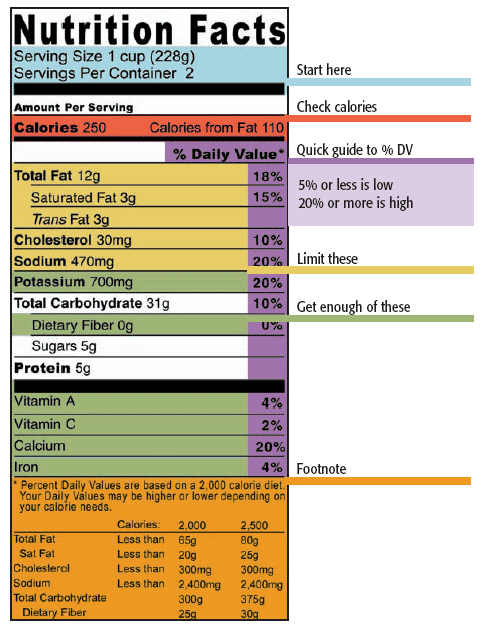|
Tips for Using the Food Label Most packaged foods have a Nutrition Facts label. Here are some tips for reading the label and making smart food choices:
Check servings and calories. Look at the serving size and how many servings
you are actually eating.
Make your calories count. Look at the calories on the label and compare them with
the nutrients they offer.
Eat less sugar. Foods with added sugars may provide calories, but few essential
nutrients. So, look for foods and beverages low in added sugars. Read the ingredient
list, and make sure added sugars are not one of the first few ingredients.
Know your fats. Look for foods low in saturated and trans fats, and cholesterol, to
help reduce the risk of heart disease. Most of the fats you eat should be polyunsaturated
and monounsaturated fats, such as those in fish, nuts, and vegetable oils.
Reduce sodium (salt); increase potassium. Research shows that eating less than
2,300 milligrams of sodium (about 1 tsp of salt) per day may reduce the risk of high
blood pressure. Older adults tend to be salt-sensitive. If you are older adult or salt-sensitive,
aim to eat no more than 1,500 milligrams of sodium each day—the equivalent
of about 3/4 teaspoon. To meet the daily potassium recommendation of at least
4,700 milligrams, consume fruits and vegetables, and fat-free and low-fat milk
products that are sources of potassium including: sweet potatoes, beet greens, white
potatoes, white beans, plain yogurt, prune juice, and bananas. These counteract some
of sodium’s effects on blood pressure.
Use the % Daily Value (% DV) column: 5% DV or less is low, and 20% DV or more
is high.

|
|||||||||||||||||||||||||||||||||||||||||||||
|
|
|||||||||||||||||||||||||||||||||||||||||||||
